#Teleosaur
Text
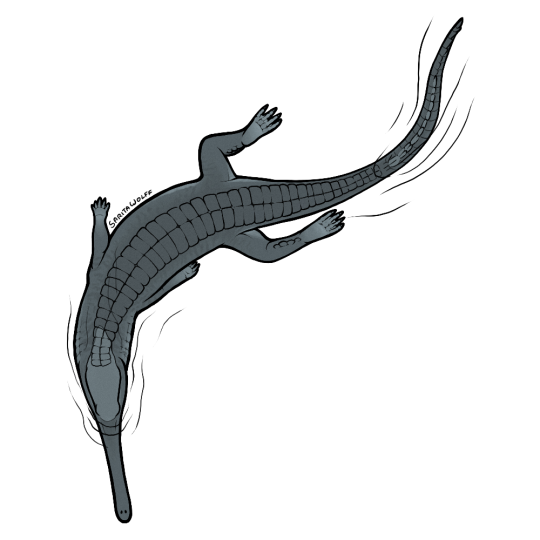
#Archovember Day 11 - Macrospondylus bollensis
The Thalattosuchians were a clade of marine pseudosuchians commonly called “marine crocodiles” or “sea crocodiles”. They were seperated into two groups, the Teleosauroids and the Metriorhynchoids. The metriorhynchoids seemed to be adapted for spending all their time in the water: they had smooth, scale-less skin, tail flukes, and even flippers. Meanwhile, teleosauroids held onto their crocodyliform nature, retaining their osteoderms and probably heading onto land when needed. They inhabited a wide range of habitats: from semi-marine coasts and estuaries, to open-ocean, to freshwater. The Early Jurassic Macrospondylus bollensis was one of these teleosauroids.
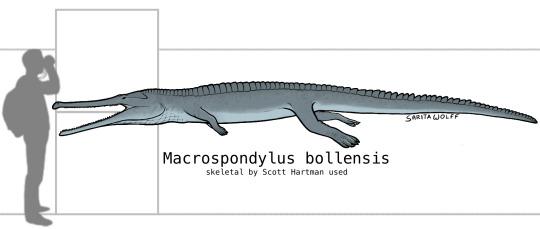
Macrospondylus bollensis, long known as “Steneosaurus bollensis” (Steneosaurus being a wastebasket taxon for thalattosuchians) finally had its genus revived in 2020. At 5.5 m (18 ft), it was the largest known Early Jurassic crocodylomorph. Like many other teleosauroids, it had a long, tapering snout, similar to its modern equivalents the gavialids. This snout would have allowed it to quickly maneuver through the water with little resistance, snapping up fish. Oddly enough, like Megalosaurus, Macrospondylus is also represented in the Crystal Palace gardens (though they are simply labeled as Teleosaurus). Modeled after gharials and based on much better preserved fossils than Megalosaurus, the teleosaur statues actually hold up pretty well, other than using a more crocodilian scute pattern.
Macrospondylus bollensis fossils have been found in Germany, the UK, and Luxembourg. It lived in the newly forming Tethys Sea, which was warm and shallow at the time, dotted with small tropical islands where Macrospondylus would have likely emerged to bask in the sun. This area is known for its fossilized crinoids, cephalopods, bivalves, crustaceans, ichthyosaurs, sharks, bony fish, and more, often exquisitely preserved “frozen in time” due to sudden events and nigh perfect fossilization factors. There was an abundance of fish here for Macrospondylus to feast upon, including chimaeras like Acanthorhina, the armoured Dapedium, the long-bodied Euthynotus, pups of the shark-like Hybodus, the herring-like Leptolepis, and many more. It would have lived alongside a variety of icthyosaurs, small plesiosaurs, other teleosauroids such as Mystriosaurus, Pelagosaurus, and Platysuchus, pterosaurs such as Campylognathoides and Dorygnathus, and come across sauropods such as Ohmdenosaurus wandering the shorelines. But Macrospondylus was not the biggest “fish” in the sea, and if it ventured into the open ocean it could have come across the 8–10 metre (26–33 ft) long icthyosaur Temnodontosaurus, the apex predator of the Early Jurassic Tethys Sea (which is also on display at the Crystal Palace!)
#my art#SaritaDrawsPalaeo#Macrospondylus#Macrospondylus bollensis#Teleosauroid#Teleosaur#Thalattosuchians#Crocodyliforms#pseudosuchians#archosaurs#archosauromorphs#reptiles#Archovember#Archovember2023
10 notes
·
View notes
Text
Crystal Palace Field Trip Part 2: Walking With Victorian Dinosaurs
[Previously: the Permian and the Triassic]
The next part of the Crystal Palace Dinosaur trail depicts the Jurassic and Cretaceous periods. Most of the featured animals here are actually marine reptiles, but a few dinosaur species do make an appearance towards the end of this section.

Although there are supposed to be three Jurassic ichthyosaur statues here, only the big Temnodontosaurus platyodon could really be seen at the time of my visit. The two smaller Ichthyosaurus communis and Leptonectes tenuirostris were almost entirely hidden by the dense plant growth on the island.

Ichthyosaurs when fully visible vs currently obscured
Left side image by Nick Richards (CC BY SA 2.0)
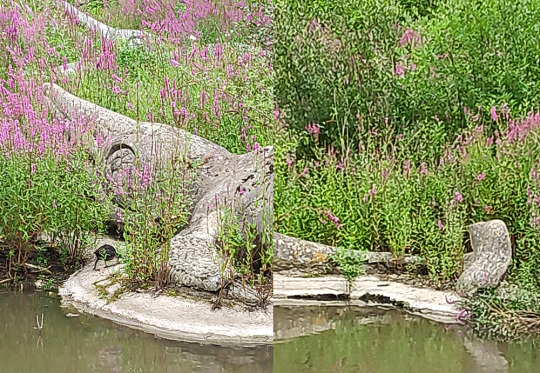
Head, flipper, and tail details of the Temnodontosaurus. A second ichthyosaur is just barely visible in the background.
Ichthyosaurs were already known from some very complete and well-preserved fossils in the 1850s, so a lot of the anatomy here still holds up fairly well even 170 years later. They even have an attempt at a tail fin despite no impressions of such a structure having been discovered yet! Some details are still noticeably wrong compared to modern knowledge, though, such as the unusual amount of shrinkwrapping on the sclerotic rings of the eyes and the bones of the flippers.

———

Arranged around the ichthyosaur, three different Jurassic plesiosaurs are also represented – “Plesiosaurus” macrocephalus with the especially sinuous neck on the left, Plesiosaurus dolichodeirus in the middle, and Thalassiodracon hawkinsi on the right.
They're all depicted here as amphibious and rather seal-like, hauling out onto the shore in the same manner as the ichthyosaurs. While good efforts for the time, we now know these animals were actually fully aquatic, that they had a lot more soft tissue bulking out their bodies, and that their necks were much less flexible.

———
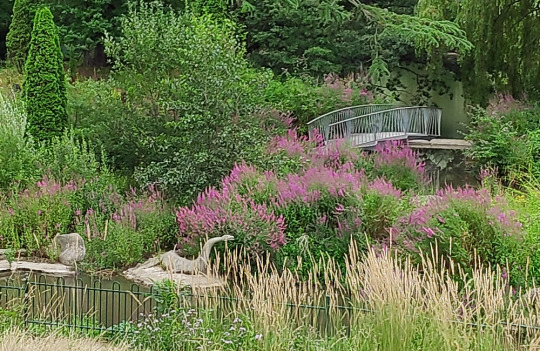
The recently-installed new pivot bridge is also visible here behind some of the marine reptiles.
———

Positioned to the left of the other marine reptiles, this partly-obscured pair of croc-like animals are teleosaurs (Teleosaurus cadomensis), a group of Jurassic semi-aquatic marine crocodylomorphs.

A better view of the two teleosaurs by MrsEllacott (CC BY-SA 4.0)
The Crystal Palace statues have the general proportions right, with long thin gharial-like snouts and fairly small limbs. But some things like the shape of the back of the head and the pattern of armored scutes are wrong, which is odd considering that those details were already well-known in the 1850s.

———
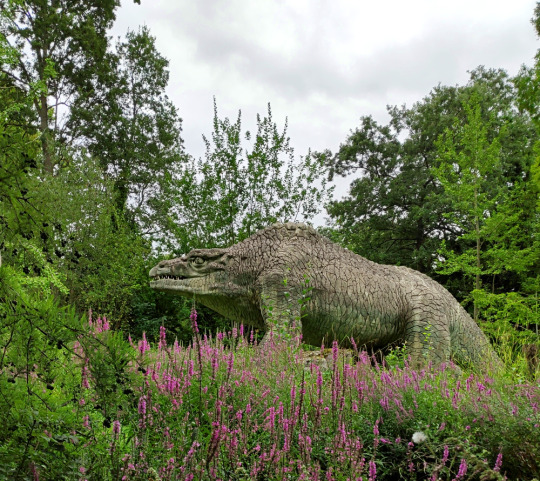
Finally we reach the first actual dinosaur, and one of the most iconic statues in the park: the Jurassic Megalosaurus!
Megalosaurus bucklandi was the very first non-avian dinosaur known to science, discovered in the 1820s almost twenty years before the term "dinosaur" was even coined.
At a time when only fragments of the full skeleton were known, and before any evidence of bipedalism had been found, the Crystal Palace rendition of Megalosaurus is a bulky quadrupedal reptile with a humped back and upright bear-like limbs. It's a surprisingly progressive interpretation for the period, giving the impression of an active mammal-like predator.
This statue suffered extensive damage to its snout in 2020, which was repaired a year later with a fiberglass "prosthesis".

———
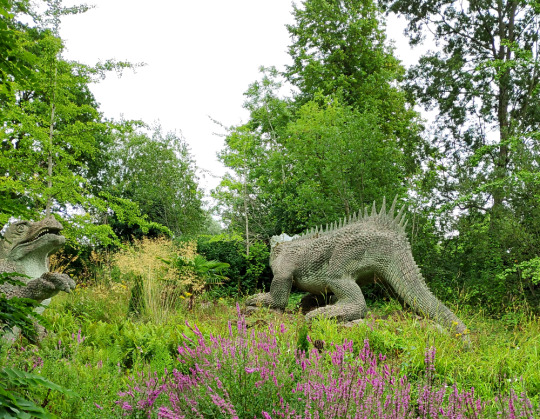
Reaching the Cretaceous period now, we find Hylaeosaurus (and one of the upcoming Iguanodon peeking in from the side).
Hylaeosaurus armatus was the first known ankylosaur, although much like the other dinosaurs here its life appearance was very poorly understood in the early days of paleontology. Considering how weird ankylosaurs would later turn out to be, the Crystal Palace depiction is a pretty good guess, showing a large heavy iguana-like quadruped with hoof-like claws and armored spiky scaly skin.
It's positioned facing away from viewers, so its face isn't very visible – but due to the head needing to be replaced with a fiberglass replica some years ago, the original can now be seen (and touched!) up close near the start of the trail.


———

Two pterosaurs (or "pterodactyles" according to the park signs) were also supposed to be just beyond the Hylaeosaurus, but plant growth had completely blocked any view of them.
Although these two statues are supposed to represent a Cretaceous species now known as Cimoliopterus cuvieri, they were probably actually modeled based on the much better known Jurassic-aged Pterodactylus antiquus.
A second set of pterosaur sculptures once stood near the teleosaurs, also based on Pterodactylus but supposed to represent a Jurassic species now known as Dolicorhamphus bucklandii. These statues went missing in the 1930s, and were eventually replaced with new fiberglass replicas in the early 2000s… only to be destroyed by vandalism just a few years later.
(The surviving pair near the Hylaeosaurus are apparently in a bit of disrepair these days, too, with the right one currently missing most of its jaws.)

Image by Ben Sutherland (CC BY 2.0)
The Crystal Palace pterosaurs weren't especially accurate even for the time, with heads much too small, swan-like necks, and bird-like wings that don't attach the membranes to the hindlimbs. Hair-like fuzz had been observed in pterosaur fossils in the 1830s, but these depictions are covered in large overlapping diamond-shaped scales due to Richard Owen's opinion that they should be scaly because they were reptiles.
But some details still hold up – the individual with folded wings is in a quadrupedal pose quite similar to modern interpretations, and the bird-like features give an overall impression of something more active and alert than the later barely-able-to-fly sluggish reptilian pterosaur depictions that would become common by the mid-20th century.

(Much like the statues themselves, the "modern" reconstruction above is based on Pterodactylus rather than Cimoliopterus)
———

The last actual dinosaurs on this dinosaur trail are the two Cretaceous Iguanodon sculptures. At the time of my visit they weren't easy to make out behind the overgrown trees, and only the back end of the standing individual was clearly visible.

Named only a year after Megalosaurus, Iguanodon was the second dinosaur ever discovered, and early reconstructions depicted it as a giant iguana-like lizard.
The Crystal Palace statues depict large bulky animals, one in an upright mammal-like stance and another reclining with one hand raised up. (This hand is usually resting on a cycad trunk, but that element appeared to be either missing or fallen over when I was there.)
Famously a New Year's dinner party was held in the body of the standing Iguanodon during its construction, although the accounts of how many people could actually fit inside it at once are probably slightly exaggerated.
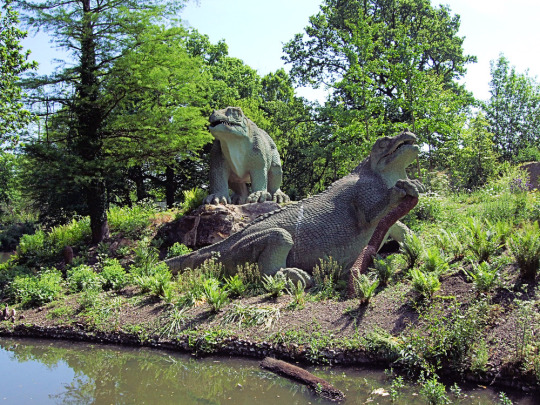
A clearer view by Jim Linwood (CC BY 2.0)
Considering that the skull of Iguanodon wasn't actually known at the time of these sculpture's creation, the head shape with a beak at the front of the jaws is actually an excellent guess. The only major issue was the nose horn, which was an understandable mistake when something as strange as a giant thumb spike had never been seen in any known animal before.

(The fossils the Crystal Palace statues are based on are actually now classified as Mantellisaurus atherfieldensis, but the "modern" reconstruction above depicts the chunkier Iguanodon bernissartensis.)
———
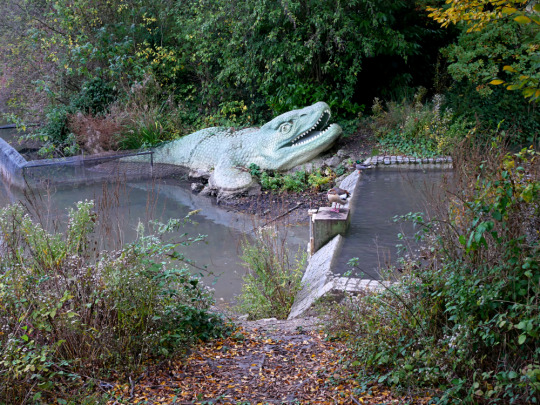
Image by Doyle of London (CC BY-SA 4.0)
I also wasn't able to spot the Cretaceous mosasaur on the other side of the island due to heavy foliage obscuring the view.
Depicting Mosasaurus hoffmannii, this model consists of only the front half of the animal lurking at the water's edge. It's unclear whether this partial reconstruction is due to uncertainty about the full appearance, or just a result of money and time running out during its creation.
The head is boxier than modern depictions, and the scales are too large, but the monitor-lizard like features and paddle-shaped flippers are still pretty close to our current understanding of these marine reptiles. It even apparently has the correct palatal teeth!

Next time: the final Cenozoic section!
#field trip!#crystal palace dinosaurs#retrosaurs#i love them your honor#crystal palace park#crystal palace#ichthyosaur#plesiosaur#teleosaurus#crocodylomorpha#marine reptile#megalosaurus#theropod#hylaeosaurus#ankylosaur#iguanodon#ornithopoda#ornithischia#dinosaur#pterodactyle#pterodactylus#pterosaur#mosasaurus#mosasaur#paleontology#vintage paleoart#art
447 notes
·
View notes
Text
Indosinosuchus the freshwater Teleosaur
Ignoring the fact that I skipped out on posting about my recent deepdives on Armadillosuchus and Odobenocetops (besides that one figure I made) on Tumblr, let me catch up by talking about Indosinosuchus.

Indosinosuchus (Indochinese Crocodile, after the Indochinese Tectonic Block) is a type of teleosaurid from the Late Jurassic Phu Kradung Formation of China. First of all the Phu Kradung is a fascinating formation with a long and somewhat convoluted dating history. For quite some time researchers argued whether or not its Late Jurassic (based on fauna) or Early Cretaceous (based on pollen). Recent papers seem to argue that both can be true, with the lower parts being Jurassic and the upper Cretaceous, which also accounts for a faunal turnover visible throughout the record. Related to Indosinosuchus, we have classically Jurassic teleosaurs in the lower levels and pholidosaurids in the upper.
artwork by Kmonvish Lawan and Sakka Weerataweemat


Whats far more interesting however is that the Phu Kradung Formation is continental in nature, preserving floodplanes dominated by lakes and rivers. This is quite the unusual habitat for a teleosaur, which are traditionally marine animals, living in the coastal or even open waters of the Tethys. In fact the only other known example of a freshwater teleosaur is an unnamed animal from China that sometimes clades closely to Indosinosuchus.
Indosinosuchus is known from a total of 10 fossil individuals, largely consistsing of skulls and mandibles with the occasional postcrania, which were all found in a single locality and have been determined to represent at least two different species: I. potamosiamensis (Thai River Indochinese Crocodile) and I. kalasinensis (Indochinese Crocodile from the Kala Province).

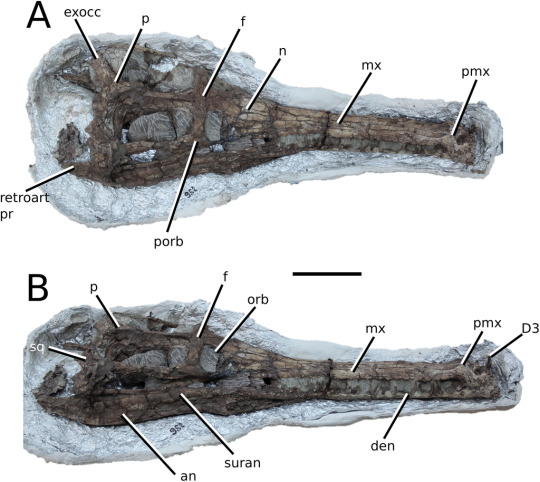
Now overall, Indosinosuchus had a pretty long and narrow snout compared to most modern crocodilians. However, among teleosaurs, this animal was actually among the more robust genera. Even more so when you consider that within teleosaurs, it falls within the teleosaurid family, not the overall more robust machimosaurids that would eventually become durophages and macropredators, cracking turtle shells.
Analysing the biomechanics of Indosinosuchus did show some cool things. The snout was pretty average at resisting stress and force, at least for teleosaurs, but the bite force was respectably high. The force that could be transferred to the tip of the snout in particular is among the highest in this group and the maximum force it could excert was the single highest among all teleosaurs.
The two species however begin to differ in how fast they could close its jaws. I. potamosiamensis follows what would be expected. A teleosaur with a massive bite but only closing its jaws slowly as in teleosaurs with similar mechanical advantage values. I. kalasinesis however could close its jaws surprisingly fast, something you'd otherwise expect from animals with a much lower bite force that needed to strike a lot more swiftly in order to catch prey.
While we don't quite know the precise ecology of the two species, scientists could deduce a few things. For one, obviously the difference in the jaw closing/opening speed is a good sign that they had somewhat different lifestyles, which could explain why two so similar species coexisted at the same time in the same place. Secondly, although its bite force was notably high, it does not appear like Indosinosuchus went after especially large prey. Sure, it could bite hard and had a relatively robust rostrum, but its teeth were not particularily specialised like in Machimosaurus. So it has been suggested that it was a generalist, not a specialist as shown in this figure by Johnson, Young and Brusatte.
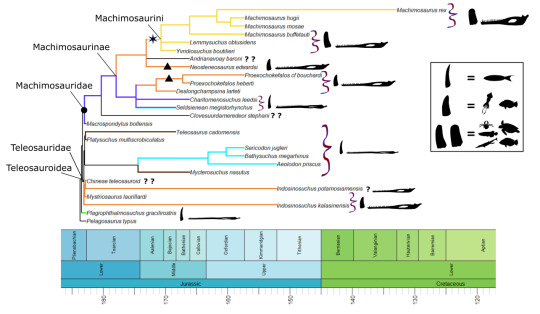
Last but certainly not least is the way these animals died. It does seem rather odd that 10 specimens all seemingly died in the same place at the same time, with most preserving the skull and not much else. Well there may be a reason. One clue stems from the most complete non-skull we have, which is a remarkably well preserved spinal column preserved in articulation, but missing the skull. So the idea is that the carcass may have floated in rather still waters (like an oxbow lake) and the weight of the head would eventually separate the two pieces. The spine must have been burried rather quickly afterwards so that it wouldn't just fall apart. Well the hypothesis continues that this could have been during a drought, when water levels were gradually receeding. We know that modern crocodiles will amass in great numbers during droughts until bodies of waters are nothing but mud and crocs, so it makes sense here. The full drying out of their sanctuary would then contribute to preservation and we even have evidence that they spend a minimum of 8 weeks in the dry thanks to the feeding traces of scavenging beetle larvae.
There is also a second hypothesis that suggests that the bodies may have been washed on land during a flashflood, but I personally think the drought hypothesis is a lot more interesting. Plus I managed to get @knuppitalism-with-ue to draw something akin to the later, with an unfortunate group of Indosinosuchus being stuck in a dried up lakebed as a local mamenchisaur approaches in the search for water.
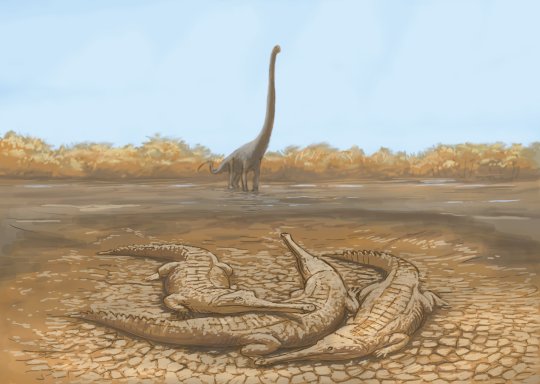
Obligatory link to the Wikipedia page post-overhaul: Indosinosuchus - Wikipedia
and the before and after, wondering if I should do the same with Armadillosuchus and Odobenocetops or if I should just come back once I got the next project done (Doratodon)
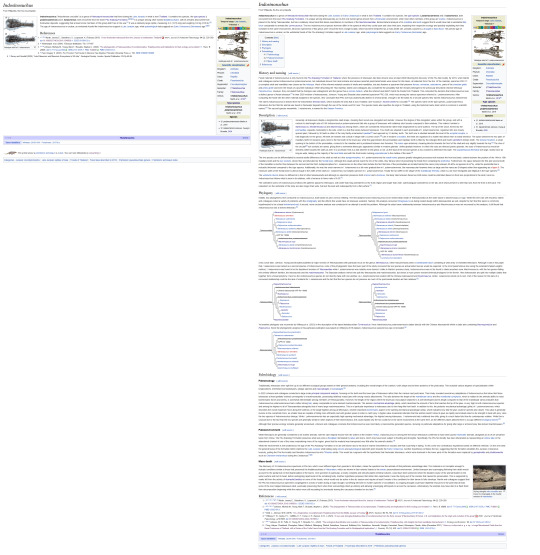
#indosinosuchus#palaeoblr#paleontology#teleosauroidea#teleosauridae#phu kradung formation#jurassic#crocodile#wikipedia editing#prehistory
32 notes
·
View notes
Text
Male + Gender neutral reader blogs!
Please remember to read the DNIs and warnings on these blogs and their contents!
Part 1 (you are here). Part 2. Part 3.
@albed-hoe
@king-bee-sting
@finlikefish
@stickychicky
@scaramoon
@kozumedenki
@tsukuyohmi
@that-foul-legacy-lover
@double-homiecide
@simping-overload
@virtual-luvr
@ethanharli
@prince-rukatinaka
@kianaslittlewhore
@localspiderboy
@k1b0s-soft-hands
@fanficfroggie
@dakas-bell
@dailytatsu
@huataos
@hellsoysauce
@topheecoffe
@dilucslittleangel
@genshin-simpact
@bruisedalbedo
@alonelysimp
@cerealyoam
@primalsouls
@soam-imaginings
@teleosaure
@xiao-lovebot
@khaishoo
@fantasy-for-two (archive @o0milky-sweet0o)
@g0thxiao
@down-the-rivver
@0hollowpurple0
@darless
@xiaosbot
@genshinfanboy
@shimishimii
@resurrectedlaughter
@cinthskiss
@deviltoys
@kanattac
@idiotic-writer
@dourpeep
@case-electris
@ceciliablossoms
237 notes
·
View notes
Photo

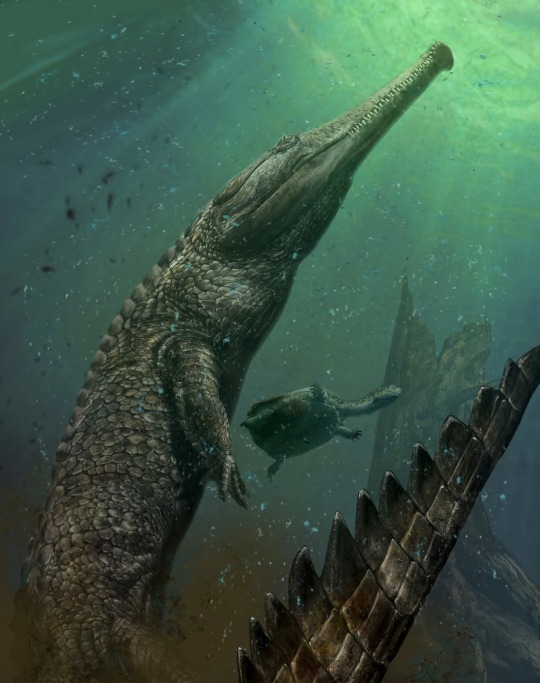
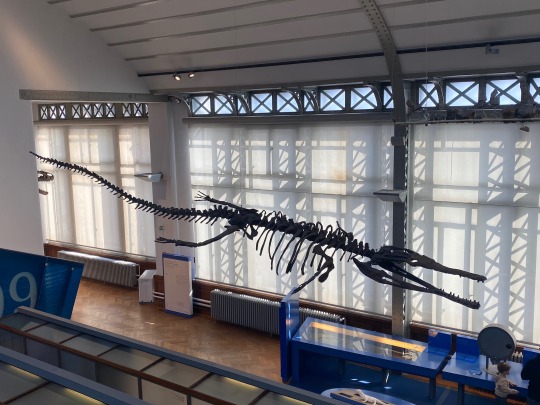
This is Machimosaurus, an impressive crocdile-like Jurassic predator from our Evolution Gallery !
Machimosaurus is a crocodyliform of the Teleosaur family, which ruled the seas and oceans from the Upper Jurassic to the Early Cretaceous.
Members of the Teleosaur family were initially more slender, with a much longer snout efficient at catching smaller preys such as fish. However, over time, Machimosaurus evolved to become particularly larger than its relatives, with a slightly shorter snout.
Semi-aquatic, Machimosaurus was able to venture ashore to hunt. However, this exceptional swimmer was a master of deep-sea hunting. In the water, it used its short legs to steer and to keep balance, while its robust tail allowed Machimosaurus to propel itself.
Other distinguishing features of this species were its massive skull and long snout. Using its conical, rounded teeth and an overpowering jaw force, Machimosaurus was able to target larger or shelled prey: fish, turtles and other marine reptiles, as well as some overly adventurous terrestrial species had to be especially cautious of this fierce predator.
Fossils of this 100-million-year-old giant have been discovered in several countries across Europe and Africa. These findings have allowed palaeontologists to separate, to this date, the lineage of Machimosaurus into five probable species.
One of these, the Machimosaurus rex recovered from a desert in Tunisia in 2016, could be the largest member of this lineage. According to various estimates, this animal could have grown up to more than 7 metres in length, for 3 tonnes: not the kind you'd want to meet in a face-off!
[Picture by visitor Merle Van Faassen, and Machimosaurus Rex illustration by Davide Bonadonna]
#naturalscience#naturalsciences#natural history#natural history museum#machimosaurus#jurassic#cretaceous#museumvisitor#naturalsciencesbrussels#royal belgian institute of natural sciences
50 notes
·
View notes
Note
@/teleosaure babes
WE CAN MAKE OUT IN THE ALLEY WAY RN NONNIE
ILYSM 4 THIS, TYSM
MWAH, MWAH, MWAH
1 note
·
View note
Text
submitted blocklist.
these people are all of the users who have interacted with a post made by tumblr user "proshipcultureis" within the month of december 2021, and can be assumed to be or support proshippers
The list will be in two versions, one with them all in a pargraph separated by a comma, and one with each url having its own line, so you can pick which one works best for you.
This is the first half of the list, the second half will be posted when I’m done blocking them.
=============================
separated by comma:
smallbiidiot, buysomecheese, daughterofdungeonbat, dogboygorou, usearki, suppuration, coolatomiccollectorcat, ahelplessidiot, condomatsu, darkfairytype, alpama, tradgothdyke, hero19873, fluffy-addison, hoarder-of-stories-27, burningchttos, scientistservant, bluejaysfeathers, zdradairl, disgusting-polymorph, strange-morningstar, teleosaure, jinglebellrockstars, midorinor, hes-kinda-sus, profic-venti, weewoofr, blueeyeddude83, olibog, funky-little-torturer, wielesys, evilista, ambiguous-bastards, gothamlioness1, ucanchangethislater, zeawesomebirdie, good7luck, proship-kitt, olympusrox, charlon-lumi, inforasight, ebi-furai-no-shitpost, deaddovesclub, cremebruleedays, 1gnihyde, sarielkitts, left-trek, beef-boy0, apocalypticromantic666, ciambellina96, aatusdump, electroniccollectiondonut, zforhire, artsycanongoer, egg-emperor, fanfarekid, star-the-honeybun, living-horrors, catzrcool, almightymonkey, zarabithia, moinsbienquekaworu, luigra, electra-iphigenie, kawaii-pigeon, stevetoppsculpture, aaadisjdksldjskdjkadnksks, zachjane, abaecchios, hopeless-system, queentexxx, neevy, sarah-k-is-cute, 23tweakedcryptid23, humanpers0n, 0p0ssumprince, poisonouscephalopod, atomicgoateephantom, bees-nest, obsessive-repressed, sunsetcarnation264, hdlssxstrnz, rl-nancyholbrook, proship-luz-noceda, zabbylovesriversong, wandering-wolf23, sirindom, mohitoma, 3am-crisis, be-kind-rewindd, merelyafigment, angels-share-proship, rpg-women, littlejowo, stupid-gay-cat, mothman-homie, crowbar-abortion, cappysuns, f1r3w00d, lolbitea, z-kane, ivysus, iamnotkaz, personalwindmill, shineheart26, magicalathleteskeletonzipper, lesbabe6, tamamizu, themasterwither, milo-mile, thewallsoctavious, sour-n-salty-citrus, whovianbi, girlcalledwhatsername, anxious-multishipper, theaveragepsychoticbitch, nightlist, coockie8, lesbiannagito, foixng, proshipcinnamon, ben-the-hyena, natepera, swordgaysafterdark, synthellasart, raggedadler-skullandreskull, biracialpercy, healerthathateshisjob, adorbzgirlz, daggo-dead-dove, tiredslugs, mx-sinisters-malewife, so-confused-itmakes-mesick, oreocookiezzz, locksnek, melodyherwholelifelong, miruunya, yugiohhetaliadork, hitthetarget-98, degenerate-otaku, firewins919, psychictoastmaker, land-of-omorashi-and-absurdities, proship-miku, coles-number-one-whore, marshmallowangel, googaoo, marshmellowtea, dead-peppermint, spaceodyssey2001, proship-pokemon, yoshiminion, pygmy-possum, skin--slave, dionastightpussy, frnkieroismydaddy, tomwise, grayseeker, wiz-witch, crimsonrose95, incelfanclub, savebatsfromscratch, marilleraine, mori-proship, ill-ship-what-i-want, lilxxbrainrot, zayray030, supercake04, gey-beans, gemalawashomestuck, vitasine, purring-tiefling, g1itchb0y-advanced, jetsetspy, fuck-naming-things, sharptootheddancer, oldsonganddance, nebulaaedits, thechimerasystem, cerehz, lesserbeans, emordnilap-fr, emerald-vulture, chaifootsteps, huggiewuggiez, jose2bjose, cereal-cereal-cereal,
=============================
single line:
0p0ssumprince
1gnihyde
3am-crisis
23tweakedcryptid23
aaadisjdksldjskdjkadnksks
aatusdump
abaecchios
adorbzgirlz
ahelplessidiot
almightymonkey
alpama
ambiguous-bastards
angels-share-proship
anxious-multishipper
apocalypticromantic666
artsycanongoer
atomicgoateephantom
be-kind-rewindd
beef-boy0
bees-nest
ben-the-hyena
biracialpercy
blueeyeddude83
bluejaysfeathers
burningchttos
buysomecheese
cappysuns
catzrcool
cereal-cereal-cereal
cerehz
chaifootsteps
charlon-lumi
ciambellina96
coles-number-one-whore
condomatsu
coockie8
coolatomiccollectorcat
cremebruleedays
crimsonrose95
crowbar-abortion
daggo-dead-dove
darkfairytype
daughterofdungeonbat
dead-peppermint
deaddovesclub
degenerate-otaku
dionastightpussy
disgusting-polymorph
dogboygorou
ebi-furai-no-shitpost
egg-emperor
electra-iphigenie
electroniccollectiondonut
emerald-vulture
emordnilap-fr
evilista
f1r3w00d
fanfarekid
firewins919
fluffy-addison
foixng
frnkieroismydaddy
fuck-naming-things
funky-little-torturer
g1itchb0y-advanced
gemalawashomestuck
gey-beans
girlcalledwhatsername
good7luck
googaoo
gothamlioness1
grayseeker
hdlssxstrnz
healerthathateshisjob
hero19873
hes-kinda-sus
hitthetarget-98
hoarder-of-stories-27
hopeless-system
huggiewuggiez
humanpers0n
iamnotkaz
ill-ship-what-i-want
incelfanclub
inforasight
ivysus
jetsetspy
jinglebellrockstars
jose2bjose
kawaii-pigeon
land-of-omorashi-and-absurdities
left-trek
lesbabe6
lesbiannagito
lesserbeans
lilxxbrainrot
littlejowo
living-horrors
locksnek
lolbitea
luigra
magicalathleteskeletonzipper
marilleraine
marshmallowangel
marshmellowtea
melodyherwholelifelong
merelyafigment
midorinor
milo-mile
miruunya
mohitoma
moinsbienquekaworu
mori-proship
mothman-homie
mx-sinisters-malewife
natepera
nebulaaedits
neevy
nightlist
obsessive-repressed
oldsonganddance
olibog
olympusrox
oreocookiezzz
personalwindmill
poisonouscephalopod
profic-venti
proship-kitt
proship-luz-noceda
proship-miku
proship-pokemon
proshipcinnamon
psychictoastmaker
purring-tiefling
pygmy-possum
queentexxx
raggedadler-skullandreskull
rl-nancyholbrook
rpg-women
sarah-k-is-cute
sarielkitts
savebatsfromscratch
scientistservant
sharptootheddancer
shineheart26
sirindom
skin--slave
smallbiidiot
so-confused-itmakes-mesick
sour-n-salty-citrus
spaceodyssey2001
star-the-honeybun
stevetoppsculpture
strange-morningstar
stupid-gay-cat
sunsetcarnation264
supercake04
suppuration
swordgaysafterdark
synthellasart
tamamizu
teleosaure
theaveragepsychoticbitch
thechimerasystem
themasterwither
thewallsoctavious
tiredslugs
tomwise
tradgothdyke
ucanchangethislater
usearki
vitasine
wandering-wolf23
weewoofr
whovianbi
wielesys
wiz-witch
yoshiminion
yugiohhetaliadork
z-kane
zabbylovesriversong
zachjane
zarabithia
zayray030
zdradairl
zeawesomebirdie
zforhire
13 notes
·
View notes
Text
SB Nation reviews: The Crystal Palace Dinosaurs

Fox Photos/Getty Images
Style 10
Content 7
Overall 8.5
When you’re only allowed to leave the house once a day, it puts a lot of pressure on the morning walk. Do I point the buggy north or south? Fortunately for me, just down the road from my house is Crystal Palace park, which offers two great benefits: first, a lot of space for social distancing and the avoidance of joggers, and second, a chance to travel back in time a few hundred million years. Even luckier, this route — down to the park, round the dinosaurs, back again — is almost exactly the right length for my daughter’s first nap of the day. Synergy in the time of corona.
From time to time, I like to imagine that the Crystal Palace dinosaurs catch somebody entirely by surprise. An unsuspecting soul, ambling along the path, KeepCup in one hand and phone in the other. Then all of a sudden: horror. A creature — a monster — scaled and dreadful, clambering out of the water, out of deep time. Teeth from a nightmare; spikes serried along its back. Cracked, staring eyes. Mouth open to bite. To roar. To … to … hang on, it’s not moving.
But even if this does happen, the shock can’t last long. Once the brain catches up with itself, it will remind its owner that the dinosaurs have all been dead for a while now. And in any case, this doesn’t look like any dinosaur you know. The legs are wrong. It’s fat in the wrong places. It’s the wrong kind of strange.
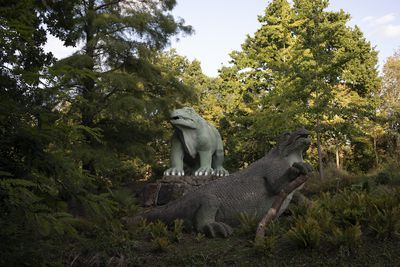
Mike Kemp/In PIctures via Getty Images
When I first saw the dinosaurs, some 15 or so years ago, I laughed. They were funny. They were wrong. They were funny because they were wrong. I was 20-odd years old and so I knew everything; certainly I knew what dinosaurs looked like. I’d seen Jurassic Park. As a child, I’d memorised every name from Aardonyx to Zupaysaurus and back again. And so, as a young and irritating adult, I knew just how silly and incorrect these weird lizards were.
They were built in the 1850s by Benjamin Waterhouse Hawkins, a sculptor and natural history artist, in collaboration with various experts in early paleontology including Richard Owen, the man who came up with the word “dinosaur.” They were based on reasoned extrapolations from the available fossils and they were, for their time, as good a job as anybody could likely have done. They became a minor sensation, and Queen Victoria and Prince Albert dropped by several times.
They even made it into literature — the titular hero of HG Wells’ Kipps takes his bride to be to walk among the “strange reminders of the possibilities of the Creator … huge effigies of iguanodons and deinotheria and mastodons and suchlike”:
Kipps meditated on the monstrous shapes in sight. “I wonder ‘ow all these old antediluvium animals for extinct,” he asked. “No one could possibly ‘ave killed ‘em.”
”Why, I know that,” said Ann. “They was overtook by the Flood …”
Kipps meditated for a while. “But I thought they had to take two of everything there was —”
”Within reason they ‘ad,” said Ann …
The Kippses left it at that. The great green and gold Labyrinthodont took no notice of their conversation. It gazed with its wonderful eyes over their heads into the infinite — inflexibly calm.
But neither history nor paleontology have been kind. The park was ravaged by fire in the 1930s and afterwards the dinosaurs became run down. Even now, despite their addition to the UK’s list of protected constructions and ongoing restoration efforts, they still seem quaint. Polish them however you like, but Hylaeosaurus looks like a Harryhausen, the Teleosaurs raise their long snouts to the air like they’re tooting on trumpets, and the Labyrinthodonts, whatever Wells might have said, look like nothing so much as a pond of idling toads.

Moment Editorial/Getty Images
Of all London’s many parks, Crystal Palace is the most post-apocalyptic. As such the dinosaurs, long-fallen monarchs dragged forward through time by their planetary heirs, suit their space well. So does the coronavirus, as it goes: the quiet skies, the awkward distance, the sense of the world moving from a known past to an unknowable future.
It is named for a vast Victorian glass exhibition house that was built in Hyde Park, up in central London, to host the Great Exhibition of 1851. After the exhibition ended the whole edifice was taken down and moved eight miles south, to preside over a newly defined park in a leafy suburb. New lakes were dug, dinosaurs were built.
The Palace is no longer there. It burned down in 1936, and subsequent movements to rebuild the thing have founded on issues of cost, of time, and a general sense that there’s always something more important to be getting on with. But you can walk around the space where it was, which is still freighted with its absence. Stone mountings support a great emptiness. Grand steps carved into the landscape lead nowhere at all. Guardian sphinxes sit at rest, with nothing to watch over.
These sphinxes were recently restored and repainted a startling shade of red, somewhere between blood and rust. This, apparently, was their original colour, back when they guarded the steps of the Exhibition, but it has the odd effect of making them seem somehow less historical than they did. Old stone, historical stone, is crumbling and grey, stained with water and furred with moss. It wears its time like a lined face; the past can be read into it. Here the search for the authentic has produced something jarring, a double anachronism: they seem neither new nor old, but rather to have fallen out of time altogether.
Being older, wiser, and significantly more tired, and being reconciled to the fact I don’t know everything and often barely know anything, which I understand to be the condition of adulthood, I no longer find the wrongness of the dinosaurs funny. But I like them a lot more than I did. There is something encouraging and heartening about their wrongness. They stand now not as monuments to the power of Victorian science, an empire extending itself into the distant past, but bear witness to the fallibility of humanity.
Because, dear reader, it turns out that I was wrong as well. Jurassic Park was wrong.
I remember, as a kid, being impressed by the teeth and the horns and all the rest but most of all by the seriousness of dinosaurs: the grand longnecks, the terrible sharptooths. Even The Land Before Time is clear that its characters’ frivolity is a consequence of their childhood; the adult dinosaurs are just as serious as they should be. The dinosaurs I grew up with, once I’d left that early childhood stage where everything can be any colour and started reading books with pretensions to accuracy, were drab creatures. They ran from grey through brown and on to dark green, with just the occasional flash of colour to keep things interesting. Serious colours: all the flavours of military camouflage
We know better now. We know — we think we know; we are currently advancing as our best guess; the science has changed — that dinosaurs, or at least quite a few of them, were riotous explosions of feathers, profusions of colour. Hilarious, dramatic, and even a little bit camp. I wonder, sometimes, as I push the buggy past the Iguanodon’s portly shape, how the feathering of dinosaurs might have altered my childhood obsession. Perhaps it would have been less serious, less taxonomic — I know all the names! I am insufferable! — and more playfully strange. Or perhaps I would have just got into stamps instead.
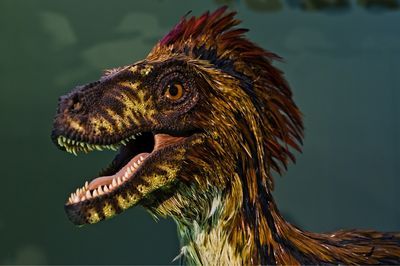
Imagno / Contributor / Getty Images
For Christmas, my partner and I bought our daughter an A to Z dinosaur poster, painted by the artist James Barker. The paintings are colourful, gleefully ridiculous, almost expressionist; a far cry from the greens and the greys of my youth. This is not an attempt to depict dinosaurs as they were, with as much accuracy as the moment allows. Rather, these are dinosaurs as they might have been. As it would have been fun for them to have been. Why shouldn’t Allosaurus be bright blue, with an orange head. Are you going to laugh at it?
The Crystal Palace monsters aimed for accuracy and so, as knowledge moved on, became ridiculous. Now they have been reclaimed, are celebrated in their wrongness. You can buy a T-shirt. Meanwhile the Crystal Palace sphinxes were restored with dutiful attention to authenticity, which has had the paradoxical effect of taking them out of all possible places. The dinosaurs on my daughter’s poster dance the line between these two: they are playfully, consciously incorrect. They peer out from behind their probable-feathers, a rainbow of possible-colours, and in their ambiguity they propose a relationship to the past that is imaginative and free. That takes what we know, acknowledges that we don’t know everything, and asks not what a thing should be, but what it could be.

Image courtesy James Barker
Fun fact: there was an Andrewsarchus. Not a dinosaur, not quite, but a prehistoric ungulate that slouched around what is now Inner Mongolia some 25 million years after the last Tyrannosaur lay down and died. As delightful as having my own almost-dinosaur was, however, it could not stop me cultivating an obscure jealousy of my brother, Peter, and his near-perfect overlap with the mighty Pteranodon.
0 notes
Text
Crystal Palace Dinosaurs

Iguanodon
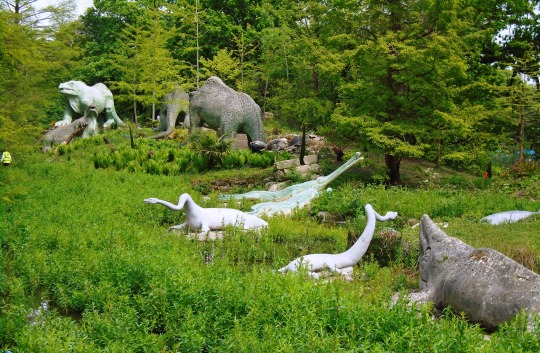
Ichthyosaur , Plesiosaurs, Teleosaur Megalosaur and Iguanondon
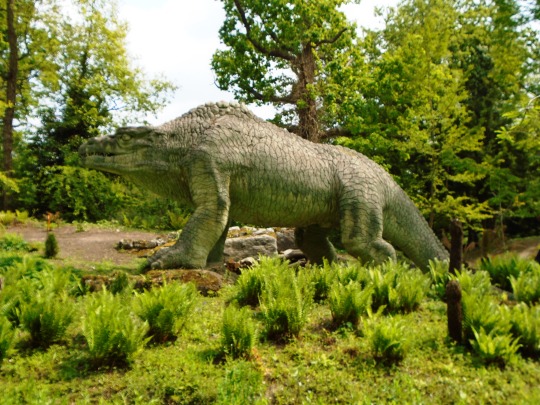
Megalosaur
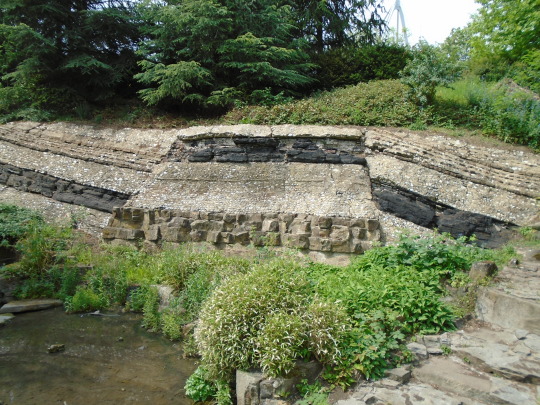
reconstructed strata with coal measures and ironstone
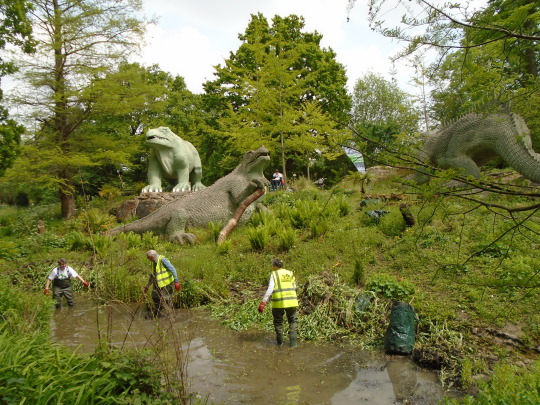
Volunteers - Gilets Jaune

Ichtyosaurs and Plesiosaur
View Larger Map https://cpdinosaurs.org/visit/what-are-crystal-palace-dinosaurs/
0 notes
Text
Hyperallergic: The First Sculptures of Dinosaurs
Dinosaur sculptures in Crystal Palace Park, London (photo by the author for Hyperallergic)
In a series for the first day of each month, Hyperallergic is exploring some firsts in art, from the earliest known depictions of things to pioneers in the visual fields.
As New Year’s Eve approached in 1853, some fashionable Londoners received a most curious party invitation. Artist Benjamin Waterhouse Hawkins requested their presence at an evening dinner, hosted in the belly of an Iguanodon. The long extinct dinosaur had been resurrected in concrete for the Crystal Palace’s new exhibition location in south London, one of over 30 extinct creatures that Hawkins would sculpt for the site.
Benjamin Waterhouse Hawkins’s studio where the Crystal Palace dinosaurs were made (1853) (via Wikimedia)
The statues are collectively known as the Crystal Palace Dinosaurs, although they comprise many non-dinosaurs such as a ground sloth, Irish Elk, and marine reptiles in the mix. They’re recognized as the first sculptural recreations of dinosaurs. Albeit a bit deteriorated, and no longer arranged chronologically, the groundbreaking artworks remain in London’s Crystal Park. Clustered on islands in the small, green space’s peaceful ponds, they still appear impressive, towering with scaly details or lurking in the water. Plesiosaurs with curled necks and crocodile-like teleosaurs were meant to impress visitors with the wonders of scientific research, by immersing them in a lost world.
They don’t quite look like the dinosaurs of our contemporary imagination, and there has long been criticism about their accuracy, even during Hawkins’s lifetime. Brian Selznick and David Serlin noted in the winter 2007/08 issue of Cabinet magazine that in 1878, a decade before Hawkins’s death, full skeletons of Iguanadons were found in Belgium, revealing they did not have spikes on their nose. Still, Hawkins did not remove the anachronistic horn. Yet they were cutting-edge for their time. As Darren Naish wrote last year for Scientific American, “they really do reflect, to remarkably detailed degree, what leading scientists of the time thought about the life appearance of the animals concerned.” This is particularly true of the research of paleontologist (and Darwin critic) Sir Richard Owen, who helped direct their design.
The dinner in the Crystal Palace Iguanodon, pictured in The Illustrated Encyclopaedia of Dinosaurs (1854) (via Wikimedia)
The Crystal Palace dinosaurs in a colored photomechanical print of the Great Exhibition (after 1854) (via Wellcome Images/Wikimedia)
Importantly, they introduced the paleontology research that had been flourishing since the early 19th century to the wider public. Zoë Lescaze in the newly published Paleoart: Visions of the Prehistoric Past writes that the dinner party “was a celebration of Hawkins’s extraordinary sculptural achievement. But it was also a glimpse of what lay ahead, the opening salvo in one artist’s single-minded campaign to free prehistoric animals from polite society and esoteric texts and unleash them on the public imagination.”
Months after the scientists, society people, and business leaders sipped claret and dined on mutton chops in the Iguanodon, the assembled dinosaurs debuted on June 10, 1854 to great public success. Visitors delighted in exploring the life-size reconstructions of long vanished animals only recently discovered, like the mosasaurus creeping in the lake, or the wide-eyed ichthyosaur identified in the early 1800s by Mary Anning. Hawkins examined fossils by hand for his art, which he sculpted with artistic license, but also compelling realism and personality for animals known solely by bones.
Dinosaur sculptures in Crystal Palace Park, London (photo by the author for Hyperallergic)
Benjamin Waterhouse Hawkins’s Central Park studio (1870s) (via Wikimedia)
New York got close to a Victorian dinosaur display of its own. Hawkins left for the United States in 1868, and soon set up a studio in the new Central Park, creating work for a planned Paleozoic Museum. Unfortunately, the powerful William M. Tweed got control of the park in 1870 and ended these plans. Hawkins, perhaps unfamiliar with “Boss” Tweed’s bullying ways, publicly protested, and the Tammany Hall leader responded by sending goons in 1871 to wreck the studio and smash the work. It’s believed their shattered fragments were thrown in the lake or buried in the park, although recent attempts to find these artifacts have turned up empty.
The Crystal Palace Dinosaurs lasted longer than the Crystal Palace itself, which burned down in 1936. The 20th century was hard on the concrete behemoths, with obscuring foliage and plants growing through the cracks in the ichthyosaur. Vandals wrecked some of the models — like the pterodactyls destroyed in 2005 — and there remains an ongoing challenge to preserve their porous material, as water can expand and crack their forms. On a visit this summer, one of the waterside beasts lacked a head, although the dinosaurs are overall looking better than ever thanks to new conservation attention. In 2007, they were upgraded to Grade I-listed monument status, and the Friends of Crystal Palace Dinosaurs were started in 2013, dedicated to conserving Hawkins’s art. Their efforts including stabilizing the Iguanodon, still remembered for that strange nighttime gathering over a century ago, and still enchanting visitors with its hulking presence in the serene suburban park.
Friends of Crystal Palace Dinosaurs banner for the recent conservation of the dinosaurs (photo by the author for Hyperallergic)
Dinosaur sculptures in Crystal Palace Park, London (photo by the author for Hyperallergic)
Dinosaur sculptures in Crystal Palace Park, London (photo by the author for Hyperallergic)
Dinosaur sculptures in Crystal Palace Park, London (photo by the author for Hyperallergic)
Dinosaur sculptures in Crystal Palace Park, London (photo by the author for Hyperallergic)
Dinosaur sculptures in Crystal Palace Park, London (photo by the author for Hyperallergic)
Dinosaur sculptures in Crystal Palace Park, London (photo by the author for Hyperallergic)
Dinosaur sculptures in Crystal Palace Park, London (photo by the author for Hyperallergic)
Dinosaur sculptures in Crystal Palace Park, London (photo by the author for Hyperallergic)
Dinosaur sculptures in Crystal Palace Park, London (photo by the author for Hyperallergic)
The post The First Sculptures of Dinosaurs appeared first on Hyperallergic.
from Hyperallergic http://ift.tt/2xCXplI
via IFTTT
0 notes
Text
Fearsome Jurassic Crocodile Named After MOTÖRHEAD's LEMMY
According to the web site of London, England’s Natural History Museum, British scientists have named the fossil of a fierce giant crocodile from the Jurassic era after late MOTÖRHEAD frontman Lemmy.
Lemmysuchus obtusidens lived around 164 million years ago during the Middle Jurassic Period and was a member of an extinct group of marine crocodile relatives called teleosaurs.
“With a meter-long…
View On WordPress
0 notes
Photo
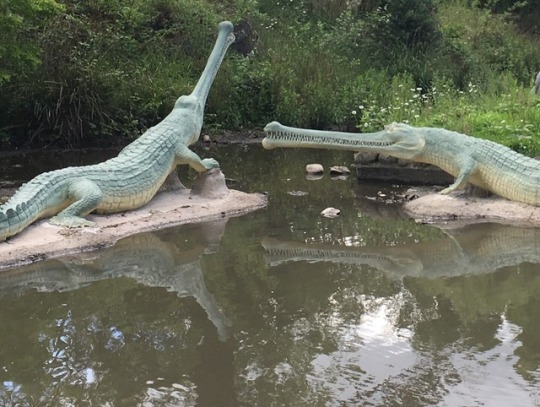
A pair of grade 1 listed teleosaurs from the 1850s.
The Crystal Palace Dinosaurs are amazing, my current top London recommendation.
0 notes